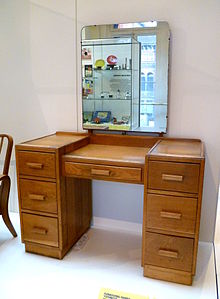Gordon Russell (designer)


Sir Sydney Gordon Russell, CBE, MC, RDI, FSIA (20 May 1892 – 7 October 1980) was an English designer, craftsman and educationist.
Biography
[edit]Gordon Russell was born in Cricklewood, London to Sydney Bolton Russell and Elizabeth Russell (née Shefford). His father was a clerk in a bank but was later offered a job by George Allsopp in Burton-on-Trent, the brewers. The family moved to live in Repton. When Gordon was twelve years old his father bought the Lygon Arms Inn in Broadway Worcestershire and the family moved again to live in the hotel. Gordon went to the Grammar School at the nearby town of Chipping Campden (or just Campden as it was known then).
In 1921 Russell married Toni Denning. In 1925 he bought a 1+1⁄2-acre plot on Kingcombe Lane near Dover's Hill overlooking Chipping Campden where they built their home, which they called Kingcombe. They lived at Kingcombe for the rest of their lives, extending it several times over the years, and raised their four children there.[1]
Career
[edit]He came under the influence of the Arts and Crafts movement from 1904 after his father had moved to Broadway in the Cotswolds to be hotelier at the Lygon Arms, through the Guild of Handicraft, the community of metalworkers, enamellers, wood carvers, furniture makers, and printers brought in 1902 by C. R. Ashbee from east London to Chipping Campden.
Following service as an officer in World War I, for which he was awarded the Military Cross in 1918,[2][3] he became a furniture maker and designer. In 1925 Russell won a gold medal at the Paris Exhibition with a cabinet, with internal drawers lined with boxwood, ebony and laburnum, and valued in 2013 at £50,000 to £60,000.[4] He designed the "Stow" range of furniture in the mid 1920s.[5][6][7]
During World War II he was instrumental in developing utility furniture as chairman of the government's Utility Furniture Design Panel. In 1943 he became chairman of the Utility Design Panel.[8] In 1947 Russell became director of the Council of Industrial Design (COID) (later renamed the Design Council). He became the first chairman of the Crafts Council.
He was awarded a knighthood in 1955 for services to design. Russell was elected to the Art Workers' Guild in 1927, and was elected as Master in 1962.[9] He was a member of the Red Rose Guild.[10] He wrote a number of books on furniture, including Furniture (1947),[11] How to Buy Furniture (1947),[12] The Story of Furniture (1947, with Jacques Groag, later published as Looking at Furniture (1953, 1964)).[13][14] In 1968 he published his autobiography, Designer's Trade.[15]
Portrait bust of Sir Gordon Russell
[edit]Gordon Russell sat for sculptor Alan Thornhill for a portrait[16] in clay. The correspondence file relating to the Russell portrait bust is held in the archive[17] of the Henry Moore Foundation's Henry Moore Institute in Leeds and the terracotta remains in the collection of the family. A Bronze is in the collection of the Gordon Russell Design Museum[18] in Broadway, Worcestershire. The museum is located in Russell's former drawing office and workshop; it was opened by Sir Terence Conran in 2008.[19]

References and sources
[edit]- References
- ^ Designer's Trade An Autobiography, Gordon Russell, George Allen & Unwin Ltd, 1968
- ^ Issue 30643 The London Gazette p. 4831 19 April 1918 Archived 14 September 2017 at the Wayback Machine
- ^ "Russell, Sir (Sydney) Gordon (1892–1980), designer and craftsman - Oxford Dictionary of National Biography". Oxford Dictionary of National Biography (online ed.). Oxford University Press. 2004. doi:10.1093/ref:odnb/31640. (Subscription or UK public library membership required.)
- ^ "Cheltenham Town Hall 2". Antiques Roadshow. Series 35. Episode 19. 14 April 2013. BBC Television. Retrieved 16 April 2013.
- ^ Myerson, Jeremy (1992). Gordon Russell: Designer of Furniture 1892–1992. London: Design Council.
- ^ Baynes, Ken; Baynes, Kate (1981). Gordon Russell. London: Design Council.
- ^ Andrews, John (2005). Arts and Crafts Furniture. Woodbridge, UK: Antique Collector's Club. ISBN 1-85149-483-9.
- ^ Woodham, Jonathan M. (1997) Twentieth-Century Design. Oxford: Oxford University Press, p. 118. ISBN 9780192842046
- ^ Myerson. J (1992). Gordon Russell: Designer of Furniture, 1892-1992. p. 6. ISBN 9780850723069.
- ^ Harrod, Tanya (1999). The crafts in Britain in the 20th Century. New Haven, USA: Yale University Press. p. 69. ISBN 0300077807.
- ^ Russell, Gordon (1947). Furniture. West Drayton (UK): Penguin Books.
- ^ Russell, Gordon (1947). How to Buy Furniture. London: Council of Industrial Design.
- ^ Russell, Gordon; Groag, Jacques (1947). The Story of Furniture. West Drayton (UK): Penguin Books (Puffin).
- ^ Russell, Gordon (1953). Looking at Furniture. London: L. Humphries.
- ^ Russell, Gordon (1968). Designer's Trade: An Autobiography. London: Allen & Unwin.
- ^ portrait head of Sir Gordon Russell Archived 19 July 2008 at the Wayback Machine image of sculpture
- ^ "Henry Moore Foundation". Archived from the original on 12 January 2009. Retrieved 10 August 2009. HMI Archive
- ^ "Gordon Russell Design Museum". Gordon Russell Design Museum.
- ^ "Gordon Russell Design Museum". www.gordonrusselldesignmuseum.org. Retrieved 21 June 2020.
- Sources
- Fiona MacCarthy, "Russell, Sir (Sydney) Gordon (1892–1980)", Oxford Dictionary of National Biography, Oxford University Press, September 2004; online edn, May 2006 accessed 9 December 2006
